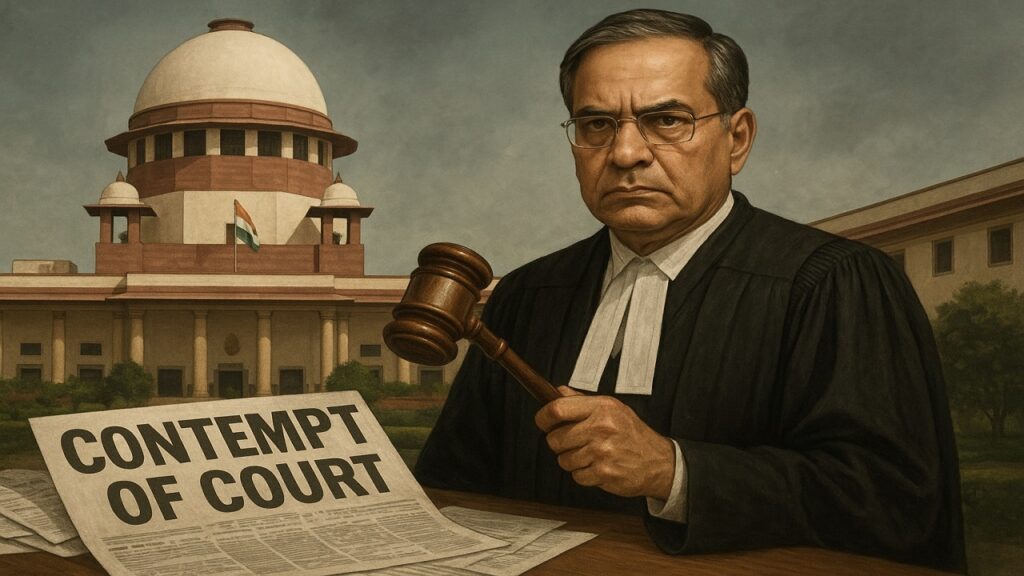Contempt of Court in India: Balancing Judicial Authority and Democratic Critique

Context:
- The issue has arisen following alleged contemptuous and derogatory remarks against the Chief Justice of India.
- The Supreme Court has viewed such remarks as acts that undermine its authority and dignity.
- The debate has brought attention to the Contempt of Court laws in India, their scope, and limitations.
1. What is Contempt of Court?
- Definition: Any act that disrespects, obstructs, or undermines the authority and dignity of the judiciary.
- Objective: To maintain judicial authority and ensure respect for legal processes.
- Origin: Derived from British colonial legal traditions prioritizing judicial authority over public criticism.
- Difference from Mere Disrespect: Goes beyond casual criticism; targets acts that disrupt or weaken the justice system.
2. Legal Framework
- Constitutional Basis: Mentioned in Article 19(2) as a reasonable restriction on fundamental freedoms.
- Procedural Gap: The Constitution does not specify procedures to initiate contempt proceedings.
- Court of Record:
- Supreme Court (Article 129) and High Courts (Article 215) are courts of record.
- They retain judgments for future reference and have inherent power to punish for contempt.
- Statutory Provision: Explained in the Contempt of Court Act, 1971.
3. Types of Contempt under Contempt of Court Act, 1971
- Civil Contempt (Section 2(b)): Willful disobedience of any court order, decree, or breach of court undertaking.
- Criminal Contempt (Section 2(c)): Acts that:
- Scandalize or lower the authority of a court
- Prejudice or interfere with judicial proceedings
- Disrupt the administration of justice in any manner
- Punishment (Section 12):
- Simple imprisonment up to 6 months
- Fine up to ₹2,000
- Or both
4. Procedures for Initiation
- Suo Motu: Courts can initiate proceedings on their own.
- Reference: Subordinate courts or Advocate General can bring matters for consideration.
- Private Petition:
- Allowed but the petitioner acts as an “informer” or “relator”, not a complainant.
- Consent Requirement: Written consent needed from Attorney General (SC) or Advocate General (HC); without it, proceedings cannot continue.
5. Criticisms of Contempt of Court
- Lack of Clarity: Ambiguities in the Act may allow judicial overreach.
- Inhibits Democratic Discourse: Fear of contempt may discourage constructive critique.
- Burden on Judiciary: Frequent proceedings divert resources from other cases.
- Colonial Legacy: Law prioritizes judicial insulation, conflicting with Article 19(1)(a).
- Potential Misuse: Judiciary acts as judge, jury, and prosecutor, raising conflict of interest concerns.
- Reduced Accountability: Powers may shield judiciary from public scrutiny, reducing transparency.
- Inconsistent Enforcement: Selective or delayed action may create perceptions of bias.
6. Judicial Stand on Contempt and Criticism
- Ashwini Kumar Ghosh vs. Arabinda Bose (1952): Fair and reasoned criticism is permissible; malicious commentary may be contemptuous.
- Anil Ratan Sarkar vs. Hirak Ghosh (2002): Contempt powers should be used cautiously and only for clear violations.
- M. V. Jayarajan vs. High Court of Kerala (2015): Abusive public speech against courts may amount to criminal contempt.
- Shanmugam @ Lakshminarayanan vs. High Court of Madras (2025): Contempt powers are meant to protect the administration of justice, not shield judges from criticism.
Conclusion:
- Balanced Approach: Citizens can critique the judiciary, but must respect its role in maintaining justice.
- Protecting Justice: Misrepresentation can undermine judicial authority and hinder delivery of substantive justice.
- Public Responsibility: Media and citizens should exercise caution to avoid interfering with judicial processes.
Source : The Hindu
